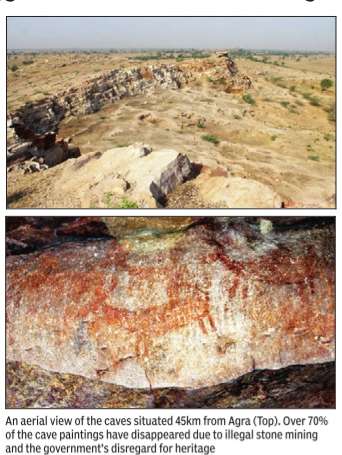Mesolithic art
This is a collection of articles archived for the excellence of their content. Readers will be able to edit existing articles and post new articles directly |
Mesolithic art
15,000 BC art at the mercy of a halwai
Avinash Kalla | Art Art, Indian Mesolithic rock-painting Rajasthan Bundi
It is not often that you come across Mesolithic art: it is as rare as it is ancient. Rajasthan’s Bundi threw up a treasure trove, rock paintings that date back to 15,000 BC. But instead of drawing attention to them and doing something to preserve the paintings, the state archaelogical department asked a halwai— who is an amateur rock-painting enthusiast—to prepare a report on the paintings. Om Prakash Sharma—Kuki to friends —was given the task because he stumbled upon the paintings during one of his expeditions last year.
“Once we get the complete report, we will take necessary steps and see what can be done for these paintings,” said B L Gupta, director, archaeology and museums, Rajasthan.
Kuki was asked to submit the report on 30 such sites in two phases. He has already given details of 20 sites and will submit the rest soon. “Last year, I was asked to submit reports which would include videography and photography in two phases and I submitted them all over a month ago.”
“These paintings in Bundi date back to Mesolithic and Neolithic ages and are precious. When the Archeological Survey of India (ASI) team visited them around 10 years ago, they authenticated many sites. After that, a number of other sites have come up, but there is no one to take care of them. A handful of locals, driven by their passion, are maintaining these sites with their limited means,” said Arvind Kumar Sharma, lecturer, Government College, Kota. He has researched the history of Bundi.
Kuki’s expeditions began about 30 years ago, but he first stumbled upon a rock painting in 1993. Since then, he has found 76 such sites, all around Bundi. “Every time I stumble upon a new site I write to the district administration and the state archeology department,” he said. Similar sites are there in MP, Jharkhand, Bihar, UP, Maharashtra and Orissa. The biggest certified rock painting site in the country is MP’s Bhimbetka, which is maintained by the ASI and Unesco, and is a world heritage site.
“The state of the sites in Bundi is sad and disheartening. Efforts should be made to preserve such priceless pieces of art. Elsewhere in MP and parts of UP like Mirzapur, state governments have taken the initative to preserve the heritage sites,” said G L Badam, secretary, Rock Art Society of India. But the Rajasthan archaelogy department decided to leave it all to Kuki, who has only studied up to Class VIII.
Agra: Pre-historic cave art
The Times of India, Jun 08 2015
Aditya Dev
Unknown to most, around 45 km from Agra and at a height of 150 feet, there were until some years ago 40 sites of grand cave paintings and shelters that belonged to the Mesolithic (Stone Age) period. Now only a few of them remain. Most have been lost to illegal stone mining and the government's disregard for history and heritage. This ancient art is located in four villages -Rasoolpur, Patsal, Madanpura and Bandroli, Almost 70% of the paintings had been destroyed, and only the efforts of a few persevering villagers had enabled the remaining specimens to somehow escape destruction. Dal Chand Dhuliya, an elderly resident of Madanpura, spoke for many villagers when he said, “We know that once these paintings are destroyed, they can't be recovered. We keep an eye on them at present, but for how long will they survive, and how long can we keep protecting them?“ The Archaeological Survey of India (ASI) amazingly has not done much to protect these paintings. When probed on why the agency has not initiated any action on preserving this heritage, ASI superintending archaeologist Bhuvan Vikrama said, “We will try and save the remaining works of art and are working on a proposal. It will be sent to the headquarters for approval.“
The remaining paintings, some still shining out in shades of maroon and ochre, show ancient men do mesticating cattle as well as engaged in hunting. Some of them depict animals like elephant and bull. The best specimens, though, are at Patsal where there are two sites locally known as Sita ki Rasoi and Nai ki Gufa. Sita ki Rasoi is a natural cave situated at a height of 150 feet where ancient men probably lived. Inside it, there is a depiction of a character that looks like a bison. At Nai ki Gufa, deer and sambar can be seen in the paintings.
M K Pundhir, medieval archaeologist from the Centre of Advance Studies in History , Aligarh Muslim Uni versity, testifies to the antiquity of this art. “The paintings are definitely from the Mesolithic period as they depict animals of four legs with smaller size and linear decoration which is how they were portrayed at that time.“
Meanwhile, an ASI official said that the caves were first discovered in 1967 in Rasoolpur at one site and later at adjoining places around 1976.When queried as to why they were not preserved by the archaeological body then, the official response was that it should have been done, but the agency's focus was more on the monuments of the area.
